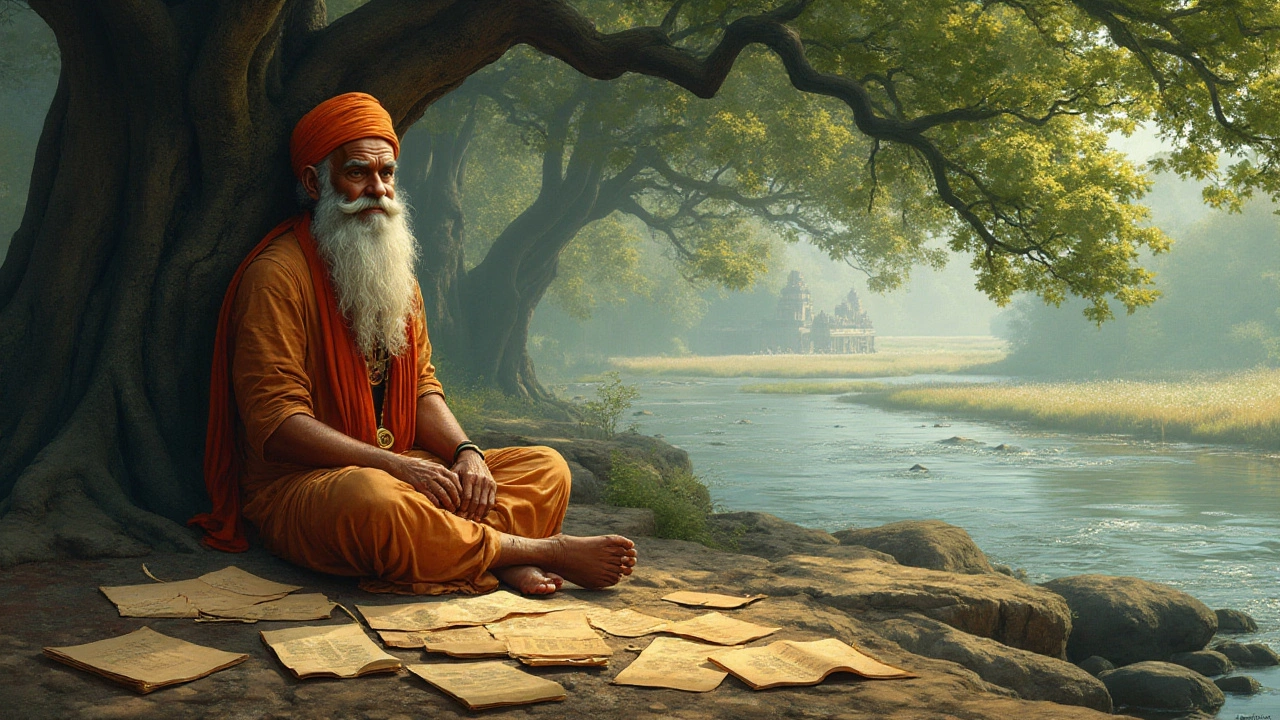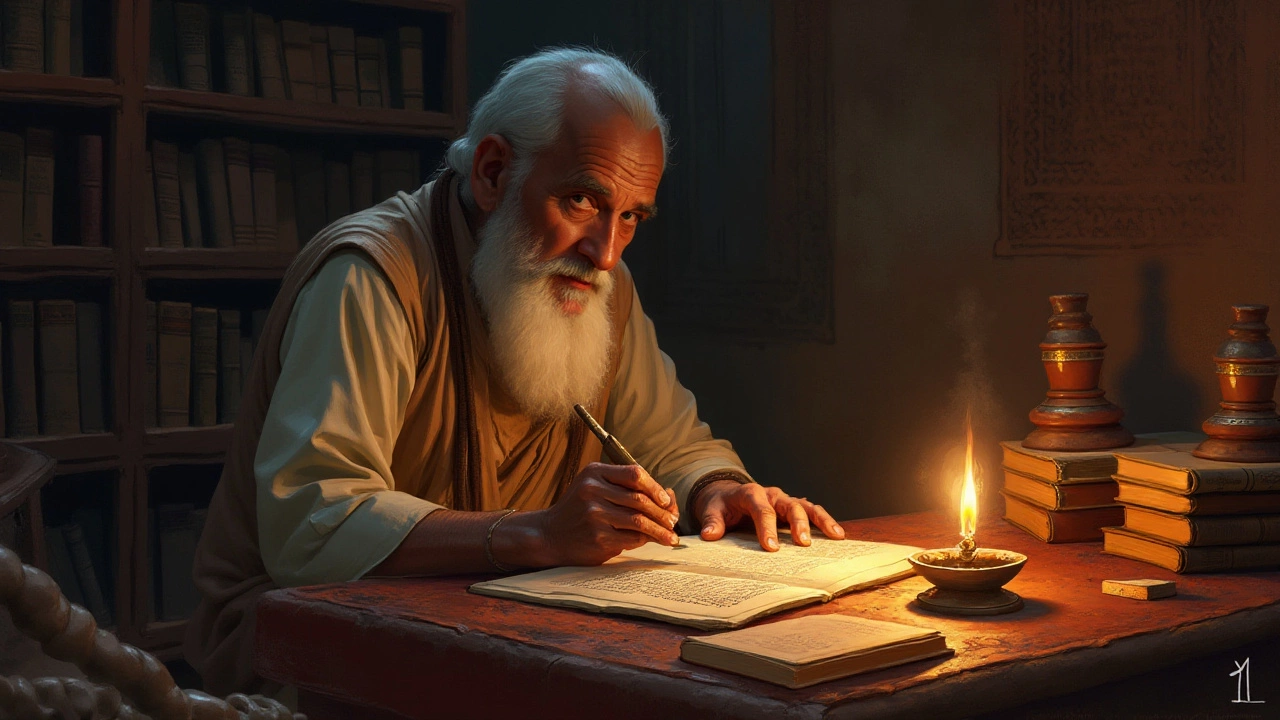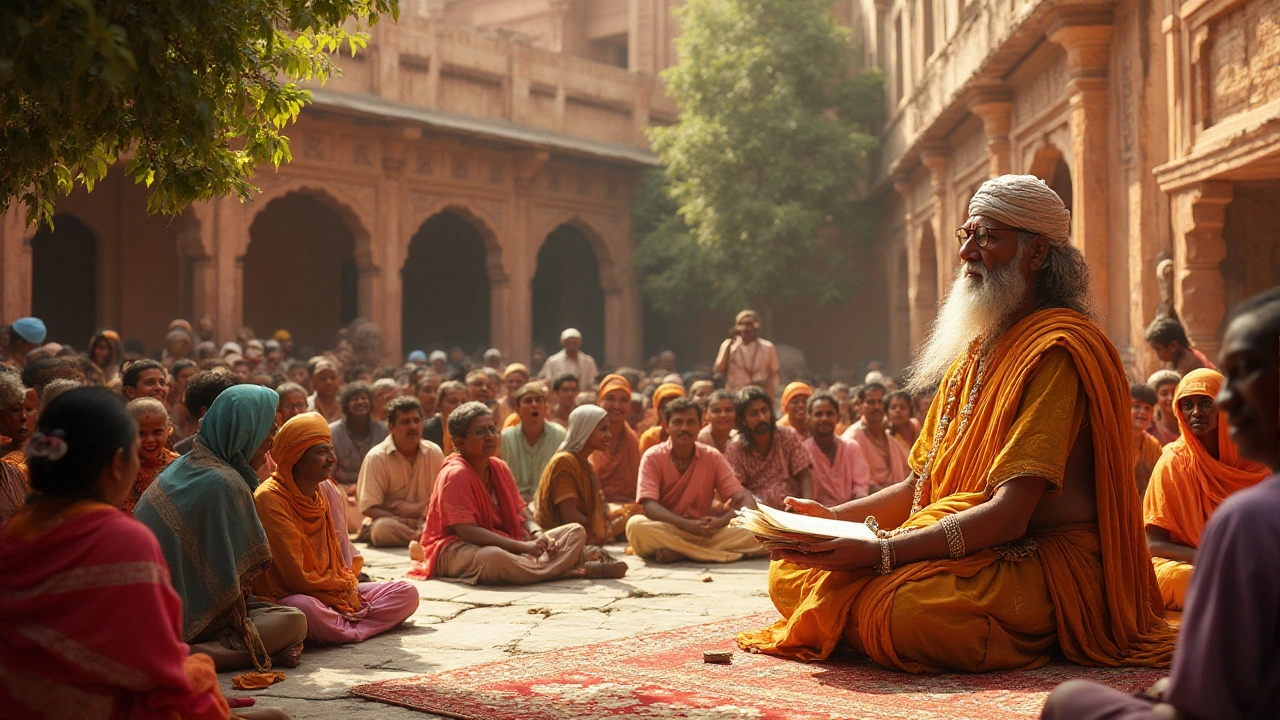
India's poetic tradition boasts a rich and diverse tapestry woven from the threads of centuries-long history. Among the numerous illustrious poets, one stands out as the earliest known to us—a figure who embodies the profound wisdom and artistic finesse of ancient India.
Delving into the annals of time, we will uncover the identity of this seminal poet, learning about their life, work, and impact on the poetic landscape that has inspired countless successors. Their story is not just about words but also about the essence of a culture rooted deeply in its love for the written and spoken verse.
Through this exploration, we will appreciate the timeless nature of poetry and its power to transcend eras while continuing to touch the human soul.
- Tracing the Origins of Indian Poetry
- Meet the Oldest Poet in India
- Life and Times: A Historical Overview
- Literary Contributions and Style
- Legacy and Influence on Modern Poetry
Tracing the Origins of Indian Poetry
Indian poetry has a storied past, tracing its origins back to the dawn of civilization on the Indian subcontinent. Literature in India began to flourish as a vibrant means of storytelling, passing down cultural values, spiritual teachings, and historical narratives long before the written word existed. Ancient Indian poetry is as diverse as the country itself, reflecting myriad influences from regional languages and dialects. The earliest poetic texts, such as the Rigveda, date back over 3,000 years, embodying a complex understanding of the universe and human experiences. During this period, poetry often served a dual purpose: as a religious chant and a source of philosophical inquiry. Through the intergenerational oral tradition, these poems were meticulously preserved, demonstrating the intrinsic importance of ancient poetry to India's psyche.
The transition from oral to written poetry marked a turning point around the time when Sanskrit emerged as the dominant language of literature, immortalizing compositions that were once ephemeral. This led to the creation of monumental epics such as the Mahabharata and Ramayana, which have left an indelible imprint on the cultural fabric of India. Poets of this era, though sometimes unknown by name, laid the groundwork for future literary marvels by interweaving intricate tales of heroism, love, and divinity with philosophical and ethical insights. This evolution of poetry can be traced through the flourishing of distinct literary forms, including the much-celebrated classical Sanskrit poetry found in Kāvya literature. According to Professor Sheldon Pollock, a renowned scholar of Sanskrit, "The power of these poems lies in their versatility, deftly bridging the divine and the human realms."
With the advent of different dynasties and regions asserting their cultural identity, new layers were added to this already rich tapestry. The Bhakti and Sufi movements of the medieval period brought about a significant transformation, emphasizing personal devotion and emotional expression, providing a new platform for poets across social and caste divides. This period also saw regional languages like Tamil, Telugu, Marathi, and Bengali emerge as prominent vehicles of poetic expression, with masterpieces that continue to captivate audiences. The illustrious works of poets such as Kabir and Mirabai highlight this shift towards more incarnate engagement with lyrics and rhythms, making poetry accessible to a broader populace. As we reflect upon the majestic landscape of Indian poetry, the nation's diversity is all the more evident, underpinned by the core belief that art transcends the temporal, linking us inexorably to the past.
Meet the Oldest Poet in India
In the realm of ancient Indian poetry, the accolade of being the oldest poet belongs to Valmiki, revered as the Adi Kavi, or the first poet in the Sanskrit literature. His magnum opus, the Ramayana, is not only a cherished epic but also a testament to his narrative brilliance and the profound depth of his insight into human emotions and ethical dilemmas. Valmiki's story is as compelling as his verses, starting with an inspiring transformation from a highway robber to a sage of great renown. It is said that the sight of a hunter killing a bird moved him to such sorrow that he uttered a shloka, or verse, which laid the foundation of Sanskrit poetry itself.
Valmiki's influence extends beyond the pages of Ramayana; it reshaped the literary landscape of his time and left an indelible mark on generations to come. His portrayal of Lord Rama as a human being, with virtues and vices, set a new standard in character development in Indian literature. The Ramayana, spread over seven Kandas or books, not only narrates Ram's journey from exile to his return to Ayodhya but also explores themes of duty, righteousness, and devotion. It is a work rich in cultural ethos and social values, resonating with lessons that are relevant even today. Valmiki’s vivid depictions of nature, the grandeur of royal courts, and the fortitude of human spirit are etched into the memory of every reader who has embarked on this literary journey.
In assessing Valmiki's legacy, it is evident that his work was instrumental in framing the very narratives through which the Indian cultural identity, moral values, and philosophy were expressed. His characters, whether it be the stalwart Rama or the valiant Hanuman, have woven themselves into the religious and cultural consciousness of the Indian subcontinent. This epic has been passed down through oral traditions, translated into numerous languages, and adapted countless times, keeping Valmiki's poetic tradition alive. It's remarkable how a single individual's creativity could have such a pervasive impact, inspiring countless retellings and molded into myriad forms across diverse artistic expressions.
Valmiki's methodological storytelling and allegorical style continue to inspire and educate. In recognizing him as the oldest poet in India, we not only honor his contribution to literature but also celebrate the beginnings of a tradition that paved the way for future poets and writers. His life serves as a poignant reminder of how transformative personal journeys can be and how art can etch timeless stories into the fabric of history. As Rabindranath Tagore once remarked in his reflections on classical Indian texts:
"Valmiki rose above the mundane existence to give voice to the eternal truths, and in doing so, he allowed others to find their souls."In every read of the Ramayana, each nuance speaks of the timeless creativity and philosophical profundity that is intrinsically tied to the roots of Indian poetry.

Life and Times: A Historical Overview
The poetic journey of ancient India is intricately entwined with its cultural and spiritual evolution. Our quest to discover the oldest poet in India leads us back to a time when poetry was not only an art form but a revered spiritual practice. This era predates much of written history, dating back to the time when oral traditions were the primary means of preserving culture and knowledge. The earliest poets were often sages and philosophers, their verses serving as both a spiritual guide and a testament to the human experience.
Among these pioneering voices, the honor of being considered the oldest traditionally falls upon Valmiki, the revered author of the ancient Indian epic, the Ramayana. Valmiki, often dubbed the 'Adi Kavi' or 'First Poet', lived in a period estimated to be around 5th to 4th century BCE—the exact dates remain an enigma, shrouded in the mists of time. His life is steeped in legend, with stories of his transformation from a highwayman to a sage providing a compelling narrative of redemption and enlightenment. His work, the Ramayana, is not just a tale of heroic adventure but a profound exploration of dharma, virtue, and human values.
An interesting aspect of Valmiki's historical context is the socio-political landscape of his time. During this period, India was a collection of small kingdoms and tribal groups, and the Aryan culture was increasingly influencing the subcontinent. The Vedic traditions were predominant, and much of the literature was either composed or performed in the sacred Sanskrit language. It was a time marked by the emergence of philosophical schools and the crystallization of ideas that would later be the foundation of Indian classical literature.
Valmiki's influence extended far beyond his lifetime. His poetic style, characterized by the precise use of meter and the development of distinct characters and scenes, laid the groundwork for future epic narratives. Over time, his work became a cultural touchstone, a cornerstone of Indian literary tradition. It inspired countless retellings and adaptations across different languages and regions, testifying to its enduring appeal and the universality of its themes. In the words of Rabindranath Tagore, "Valmiki’s work is an account not only of heroism but a universal narrative of an essential human journey."
The Ramayana, along with other ancient texts, was more than just literature; it served as an educational tool and cultural cornerstone. It's said that the tradition of reciting it was akin to attending a school, where lessons of life, morality, and spirituality were taught through its verses. This legacy of didactic poetry had a far-reaching impact, influencing subsequent generations of poets, artists, and philosophers in India and beyond. Even today, the reverence for Valmiki and the power of his words echo in the way his tales are still recounted during festivals and cultural events around the world.
Literary Contributions and Style
The journey into the literary contributions and style of India's oldest poet unveils a mesmerizing tapestry woven from the rich yarns of spiritual insight, cultural ethos, and artistic brilliance. This ancient poet, often celebrated for their profound philosophical themes embedded in sublime verse, was a pioneering force shaping the contours of early Indian poetry. Their work was characterized by a symbiotic blend of oral tradition and emerging written forms, providing a crucial link between these two modes of expression.
The core of their literary genius lay in the ability to express complex spiritual and philosophical ideas in a language both accessible and mystically profound. It is by no accident that their verses echoed through the corridors of time, being as spiritually enlightening as they were culturally reflective. Their words resonate with the ancient tradition of meditation and reflection, often employing metaphors drawn from nature and daily life, making them relatable to the common man while also offering fodder for deeper contemplation.
One distinctive aspect of their poetic style was the use of symbolism and allegory, techniques that enabled them to layer meaning within their poems subtly. This approach allowed multiple levels of interpretation, engaging readers in a dialogue with the text itself. Their style was simple yet profound, achieving an elegance and lucidity that remains unmatched in many ways. For instance, they frequently drew upon the imagery of rivers and journeys, using these as metaphors for the spiritual quest and the search for enlightenment.
"In the flowing water, see the self; in the endless waves, find the path." - Ancient Verse
Additionally, the structure of their poetry often mirrored the patterns of nature, encompassing cycles and rhythms found within the universe, thus grounding lofty philosophical discourses in the reality of the world around them. They were known to employ repetitive sound patterns and cadences, which added a musicality to their work, a nod to the oral tradition from which their poetry heavily borrowed. This rhythmic element served both to enhance memorability and to impart a meditative quality to the reading or recitation of their verses.
While much of their extant work has come down to us through sacred texts and oral narratives, its impact on the literary history of the Indian subcontinent is undeniable. They provided a foundation upon which subsequent poets built, offering a model of poetic expression that was both technically innovative and deeply rooted in spiritual wisdom. The oldest known poet of India richly contributed to the canon of early Indian literature, leaving a legacy that transcends time and continues to inspire modern interpretations and adaptations.

Legacy and Influence on Modern Poetry
The legacy of India's oldest poet continues to echo through the vast corridors of modern poetry, offering both inspiration and a benchmark for contemporary writers. This age-old bard, steeped in the cultural and religious tapestries of their time, provided a model of succinct yet profound expression that persists as an exemplar of literary art. Their compositions, in their simplicity and depth, have come to symbolize the unchanging human emotions and experiences, which still resonate with today’s audiences. Modern poets often turn to these ancient works as a source of inspiration, drawing on their themes and stylistic nuances to create a bridge between past and present.
The influence of such an iconic figure is not limited to a mere imitation of style but rather extends to the philosophical and thematic underpinnings of modern poetic works. The timeless motifs of love, nature, conflict, and spirituality that the oldest poet articulated in their verses find reflection in contemporary works, albeit through the lens of today’s issues and ideologies. This interconnection highlights a remarkable continuity in the literary tradition, where ancient insights are reimagined to address the modern context's challenges and complexities.
The Reverberations of Ancient Wisdom
This poetic lineage also lays down a framework for a cross-cultural dialogue, demonstrating the permeability of poetry as a form across epochs and geographies. The works of ancient Indian poets have transcended national boundaries, influencing poets and writers beyond India's borders, reaffirming poetry's universal appeal. In fact, many established poets cite India's oldest poetry as a source of inspiration, underscoring the enduring impact of these ancient texts on the global literary landscape.
The great Indian writer and philosopher Rabindranath Tagore noted, "It's the light of the million stars that brightens my home," attributing his creative exploration partly to the foundational works of ancient Indian poetry.
In encapsulating the spirit of its era, the poetry of India's earliest bard offers insights into the ethos and spirituality of ancient India, which are as relevant today as they were centuries ago. Their work not only upholds the rich literary heritage of India but also serves as a testament to the timeless human quest for meaning, beauty, and truth.